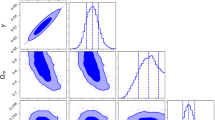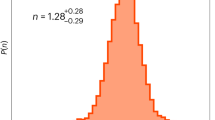Abstract
Discrete Fourier analysis on the quasar number count, as a function of redshift, z, calculated from the Sloan Digital Sky Survey DR6 release appears to indicate that quasars have preferred periodic redshifts with redshift intervals of 0.258, 0.312, 0.44, 0.63, and 1.1. However the same periods are found in the mean of the zConf parameter used to flag the reliability of the spectroscopic measurements. It follows that these redshift periods must result from some selection effect, as yet undetermined. It does not signal any intrinsic (quantized) redshifts in the quasars in Sloan survey data. However this result does not rule out the possibility as found in earlier studies of other data.
Similar content being viewed by others
References
Adelman-McCarthy, J.K., et al.: Astrophys. J. Suppl. 175, 297 (2008)
Astrophysical Research Consortium (ARC) and the Sloan Digital Sky Survey, SDSS) Collaboration. The SDSS Web site is www.sdss.org
Bell, M.B.: Astrophys. J. 566, 705 (2002a)
Bell, M.B.: 2002b, preprint (arXiv:astro-ph/0208320)
Bell, M.B.: 2002c, preprint (arXiv:astro-ph/0211901)
Bell, M.B., McDiarmid, D.: Astrophys. J. 648, 140 (2006)
Burbidge, G.: Astrophys. J. 154, L41 (1968)
Burbidge, G., Hewitt, A.: Astrophys. J. 359, L33 (1990)
Burbidge, G., Napier, W.M.: Astrophys. J. 121, 21 (2001)
Karlsson, K.G.: Astron. Astrophys. 13, 333 (1971)
Karlsson, K.G.: Astron. Astrophys. 58, 237 (1977)
Schneider, D., et al.: Astron. J. 134, 102 (2007)
Author information
Authors and Affiliations
Corresponding author
Rights and permissions
About this article
Cite this article
Hartnett, J.G. Unknown selection effect simulates redshift periodicity in quasar number counts from Sloan Digital Sky Survey. Astrophys Space Sci 324, 13 (2009). https://doi.org/10.1007/s10509-009-0151-2
Received:
Accepted:
Published:
DOI: https://doi.org/10.1007/s10509-009-0151-2




